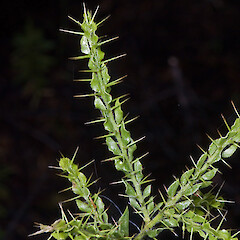Acacia paradoxa
Common name
kangaroo acacia
Family
Fabaceae
Flora category
Vascular – Exotic
Structural class
Trees & Shrubs - Dicotyledons
Conservation status
Not applicable
Habitat
Open sites usually of low fertility near the coast.
Detailed description
Small shrub to 3m high. Twigs furrowed, moderately hairy. Leaves reduced to phyllodes. Phyllodes alternate, glabrous or sparsely hairy, ovate asymmetrical up to 18 x 8 mm. Stipules are usually hardened to form a spine. Inflorescence consists of many golden yellow flowers held in solitary globbose heads. Seed pods are straight or curved and up to 50 mm long.
Similar taxa
This species is easily identified by the combination of small, broad phyllodes and the singular golden yellow globbose flower heads. It also has obvious spines.
Flowering
July, August, September, October
Flower colours
Cream, Yellow
Life cycle
Large quantities of seed produced. Seed probably remains viable for a long period. Not known to sucker. Spread by people as an ornamental hedge plant. Spreads locally by wind and gravity.
Year naturalised
1911
Origin
W. and E. Australia
Reason for introduction
Ornamental
Tolerances
Extremely hardy withstands drought, has the ability to persist in low fertility sand and sandstone country. Tolerates salt and frosts.
Etymology
acacia: Derived from Greek ‘akazo’ to sharpen, meaning point; spine or thorn.
paradoxa: From Greek ‘paradoxos’ = unexpected, strange, marvellous


